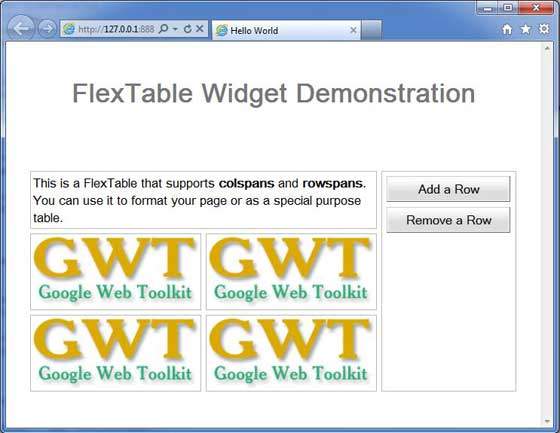
- GWT - Home
- GWT - Overview
- GWT - Environment Setup
- GWT - Applications
- GWT - Create Application
- GWT - Deploy Application
- GWT - Style with CSS
- GWT - Basic Widgets
- GWT - Form Widgets
- GWT - Complex widgets
- GWT - Layout Panels
- GWT - Event Handling
- GWT - Custom Widgets
- GWT - UIBinder
- GWT - RPC Communication
- GWT - JUnit Integration
- GWT - Debugging Application
- GWT - Internationalization
- GWT - History Class
- GWT - Bookmark Support
- GWT - Logging Framework
GWT - FlexTable Widget
Introduction
The FlexTable widget represents a flexible table that creates cells on demand. It can be jagged (that is, each row can contain a different number of cells) and individual cells can be set to span multiple rows or columns.
Class Declaration
Following is the declaration for com.google.gwt.user.client.ui.FlowPanel class −
public class FlexTable extends HTMLTable
Class Constructors
| Sr.No. | Constructor & Description |
|---|---|
| 1 |
FlexTable() Constructor for empty Flex Table. |
Class Methods
| Sr.No. | Function name & Description |
|---|---|
| 1 |
void addCell(int row) Appends a cell to the specified row. |
| 2 |
int getCellCount(int row) Gets the number of cells on a given row. |
| 3 |
FlexTable.FlexCellFormatter getFlexCellFormatter() Explicitly gets the FlexTable.FlexCellFormatter. |
| 4 |
int getRowCount() Gets the number of rows. |
| 5 |
void insertCell(int beforeRow, int beforeColumn) Inserts a cell into the FlexTable. |
| 6 |
int insertRow(int beforeRow) Inserts a row into the FlexTable. |
| 7 |
protected void prepareCell(int row, int column) Ensure that the cell exists. |
| 8 |
protected void prepareRow(int row) Ensure that the row exists. |
| 9 |
void removeAllRows() Remove all rows in this table. |
| 10 |
void removeCell(int row, int col) Removes the specified cell from the table. |
| 11 |
void removeCells(int row, int column, int num) Removes a number of cells from a row in the table. |
| 12 |
void removeRow(int row) Removes the specified row from the table. |
Methods Inherited
This class inherits methods from the following classes −
com.google.gwt.user.client.ui.UIObject
com.google.gwt.user.client.ui.Widget
com.google.gwt.user.client.ui.Panel
com.google.gwt.user.client.ui.HTMLTable
java.lang.Object
FlexTable Widget Example
This example will take you through simple steps to show usage of a FlexTable Widget in GWT. Follow the following steps to update the GWT application we created in GWT - Create Application chapter −
| Step | Description |
|---|---|
| 1 | Create a project with a name HelloWorld under a package com.tutorialspoint as explained in the GWT - Create Application chapter. |
| 2 | Modify HelloWorld.gwt.xml, HelloWorld.css, HelloWorld.html and HelloWorld.java as explained below. Keep rest of the files unchanged. |
| 3 | Compile and run the application to verify the result of the implemented logic. |
Following is the content of the modified module descriptor src/com.tutorialspoint/HelloWorld.gwt.xml.
<?xml version = "1.0" encoding = "UTF-8"?> <module rename-to = 'helloworld'> <!-- Inherit the core Web Toolkit stuff. --> <inherits name = 'com.google.gwt.user.User'/> <!-- Inherit the default GWT style sheet. --> <inherits name = 'com.google.gwt.user.theme.clean.Clean'/> <!-- Specify the app entry point class. --> <entry-point class = 'com.tutorialspoint.client.HelloWorld'/> <!-- Specify the paths for translatable code --> <source path = 'client'/> <source path = 'shared'/> </module>
Following is the content of the modified Style Sheet file war/HelloWorld.css.
body {
text-align: center;
font-family: verdana, sans-serif;
}
h1 {
font-size: 2em;
font-weight: bold;
color: #777777;
margin: 40px 0px 70px;
text-align: center;
}
.flexTable td {
border: 1px solid #BBBBBB;
padding: 3px;
}
.flexTable-buttonPanel td {
border: 0px;
}
.fixedWidthButton {
width: 150px;
}
Following is the content of the modified HTML host file war/HelloWorld.html.
<html>
<head>
<title>Hello World</title>
<link rel = "stylesheet" href = "HelloWorld.css"/>
<script language = "javascript" src = "helloworld/helloworld.nocache.js">
</script>
</head>
<body>
<h1>FlexTable Widget Demonstration</h1>
<div id = "gwtContainer"></div>
</body>
</html>
Let us have following content of Java file src/com.tutorialspoint/HelloWorld.java which will demonstrate use of FlexTable widget.
package com.tutorialspoint.client;
import com.google.gwt.core.client.EntryPoint;
import com.google.gwt.event.dom.client.ClickEvent;
import com.google.gwt.event.dom.client.ClickHandler;
import com.google.gwt.user.client.ui.Button;
import com.google.gwt.user.client.ui.DecoratorPanel;
import com.google.gwt.user.client.ui.FlexTable;
import com.google.gwt.user.client.ui.FlexTable.FlexCellFormatter;
import com.google.gwt.user.client.ui.HasHorizontalAlignment;
import com.google.gwt.user.client.ui.HasVerticalAlignment;
import com.google.gwt.user.client.ui.Image;
import com.google.gwt.user.client.ui.RootPanel;
import com.google.gwt.user.client.ui.VerticalPanel;
public class HelloWorld implements EntryPoint {
public void onModuleLoad() {
// Create a Flex Table
final FlexTable flexTable = new FlexTable();
FlexCellFormatter cellFormatter = flexTable.getFlexCellFormatter();
flexTable.addStyleName("flexTable");
flexTable.setWidth("32em");
flexTable.setCellSpacing(5);
flexTable.setCellPadding(3);
// Add some text
cellFormatter.setHorizontalAlignment(
0, 1, HasHorizontalAlignment.ALIGN_LEFT);
flexTable.setHTML(0, 0, "This is a FlexTable that supports"
+" <b>colspans</b> and <b>rowspans</b>."
+" You can use it to format your page"
+" or as a special purpose table.");
cellFormatter.setColSpan(0, 0, 2);
// Add a button that will add more rows to the table
Button addRowButton = new Button("Add a Row");
addRowButton.addClickHandler(new ClickHandler() {
@Override
public void onClick(ClickEvent event) {
addRow(flexTable);
}
});
addRowButton.addStyleName("fixedWidthButton");
// Add a button that will add more rows to the table
Button removeRowButton = new Button("Remove a Row");
removeRowButton.addClickHandler(new ClickHandler() {
@Override
public void onClick(ClickEvent event) {
removeRow(flexTable);
}
});
removeRowButton.addStyleName("fixedWidthButton");
VerticalPanel buttonPanel = new VerticalPanel();
buttonPanel.setStyleName("flexTable-buttonPanel");
buttonPanel.add(addRowButton);
buttonPanel.add(removeRowButton);
flexTable.setWidget(0, 1, buttonPanel);
cellFormatter.setVerticalAlignment(0, 1,
HasVerticalAlignment.ALIGN_TOP);
// Add two rows to start
addRow(flexTable);
addRow(flexTable);
// Add the widgets to the root panel.
RootPanel.get().add(flexTable);
}
/**
* Add a row to the flex table.
*/
private void addRow(FlexTable flexTable) {
int numRows = flexTable.getRowCount();
flexTable.setWidget(numRows, 0,
new Image("http://www.tutorialspoint.com/images/gwt-mini.png"));
flexTable.setWidget(numRows, 1,
new Image("http://www.tutorialspoint.com/images/gwt-mini.png"));
flexTable.getFlexCellFormatter().setRowSpan(0, 1, numRows + 1);
}
/**
* Remove a row from the flex table.
*/
private void removeRow(FlexTable flexTable) {
int numRows = flexTable.getRowCount();
if (numRows > 1) {
flexTable.removeRow(numRows - 1);
flexTable.getFlexCellFormatter().setRowSpan(0, 1, numRows - 1);
}
}
}
Once you are ready with all the changes done, let us compile and run the application in development mode as we did in GWT - Create Application chapter. If everything is fine with your application, this will produce following result −
